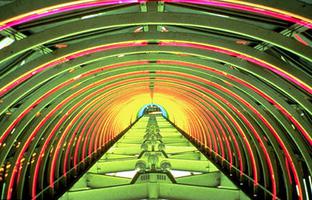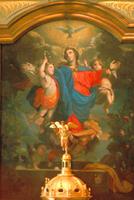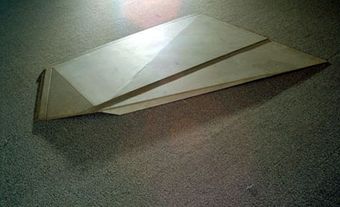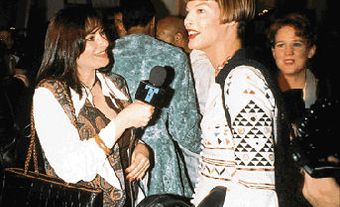Public art is commissioned for a specific public space by an individual or a group. Parks, government buildings, banks, schools, churches, hotels, stations, head offices and restaurants are some of the settings for displaying immobile works, with the composition, dimensions and proportions blending into and gaining meaning from the surroundings. The theme of the particular artwork may relate to the function of the building or environment it enhances. Public art is often produced for celebrations or propaganda, commemorative and educational purposes. The decorative function may be coupled with a political, social or religious message that represents the ideology of the group or individual who commissioned it.
Among Indigenous people in North America many tribes produced an elaborate public art, particularly in the form of wood carvings. This art served both a social and ritual function (see Aboriginal Art; Inuit Art; Northwest Coast Aboriginal Art).
During the French regime the most common form of public art was SCULPTURE. Paintings, mostly imported, were small and adaptable to different settings, and only Frère LUC designed paintings that blended with the architecture of the retables. In 1686 Intendant Bochart de Champigny had the bronze bust of Louis XIV erected in Place Royale, Québec City. Intersections were decorated with statues of saints in niches of corner buildings, and these ornaments helped to identify particular streets. Monumental sculptures, mostly carved in wood, graced the facades of churches, such as Ste-Famille (Ile d'Orléans) or Cap-Santé (Portneuf), and the retables on the main altar were rich in gilded statues, bas-reliefs and paintings. One of the most beautiful examples, executed by Pierre-Noël Levasseur and members of his workshop, is found in the Ursulines' Chapel in Québec City.
In the 18th and 19th centuries sculptors expanded into the field of naval sculpture and made the names of Québec and Maritime shipyards and shipowners known throughout the Atlantic world. The tradition of religious and naval sculpture was maintained during the 19th century by members of the Baillairgé family in Québec and by the workshops of Quévillon and his competitors in the Montréal region.
These early examples were tied to French cultural traditions and marked the presence of a royal and Catholic power. Changes brought about as a result of the Conquest were mainly iconographic. The new political power was less demonstrative, and government buildings were surmounted by British arms. The major example of this change in political power is a stone column dominating the city of Montréal, constructed in 1808 to celebrate Admiral Nelson's victory at Trafalgar (1805). In 1828 a stone obelisk was dedicated in Québec City to the memory of Generals Montcalm and Wolfe. It became the first of similar austere monuments in Canada commemorating valour in death.
The flourishing economy, growing population and arrival of itinerant immigrant artists in the colony led to a proliferation of public artworks. In the 19th century, ephemerals were popular, works such as triumphal arches, allegorical chariots, and posters (see Painting). Artists Louis Dulongpré, Joseph Légaré and, later, Alfred Pellan all produced theatre sets.
Mural painting was inspired originally by foreign artists, chiefly from Italy and Germany. The earliest documented example of a painted décor, designed as a whole and created on site in collaboration with the architect, were the columns and vault of Notre-Dame in Montréal in the years following 1828. In 1844, reflecting a growing secularization in art in Canada, Andrew Morris produced the allegories of Commerce and Agriculture for Montréal's legislative building.
In Europe the Nazarenes and pre-Raphaelites encouraged public art, an influence absorbed by the Canadian Catholic clergy during their frequent trips abroad. Immigrant artists such as Lamprecht at St Romuald Church, the Mulleir brothers at Gésu in Montréal and Luigi Cappello in the Montréal region left evidence of their ability to create an entire iconographic program in proportion to the architecture for which it was designed. In sculpture, Italian artists introduced to Canada a taste for elaborate funeral stelae and monuments, often decorated in relief bronze or figures in the round. The Montréal firm of Carli and Petrucci was a leader in the eastern Canadian market at the end of the 19th century.
Gradually, Canadian artists took over the market for mural painting as major programs for commemorative monuments encouraged the development of their careers. A rich iconographic decoration was planned for the façade of the Québec legislative building, though work was delayed until 1890, when Louis-Philippe Hébert produced sculptures of Frontenac, Elgin, Salaberry, Wolfe, Montcalm, Lévis and the groups Halte dans la forêt and Pêche au nigog. Napoléon Bourassa, who completed his training in Italy and France, was the pioneer Canadian muralist, the architect and decorator of Notre-Dame-de-Lourdes in 1883 and founder of a studio where Hébert and many mural painters were trained.
The decoration by 5 young artists of the Sacré-Coeur Chapel in Notre-Dame in Montréal marked the domination by Canadian artists of mural art. Charles Huot and Ozias Leduc continued well into the 20th century to develop Canadian themes directly related to the setting. With political evolution came a greater awareness of history, and local historical societies, historians and genealogists multiplied. The number of historical figures and events that had to be marked increased rapidly and fathers of the new Canadian nation such as George-Étienne Cartier and John A. Macdonald were celebrated in many monuments (see Robert Harris).
In Toronto in 1899 George A. Reid designed a series for the lobby of the new City Hall depicting the establishment of settlements in Upper Canada. Although this project was not completed, he left several important murals in Toronto, among them those of the Earlscourt Library and the auditorium of Jarvis Collegiate Institute. Like most mural artists in Canada at that time, Reid did not use the fresco technique, but mounted the painted canvas on the wall. In Europe and the US, at the turn of the century, vast construction projects featuring sculpture monuments, murals, mosaics and stained-glass windows were popular. In 1898 the Toronto Guild of Civic Art was established and, after 1895, the Royal Canadian Academy of Arts sometimes devoted a room during its annual expositions to mural painting.
As a relatively peaceful country, Canada had few war memorials. The War of 1812 was commemorated by a heroic statue of Isaac Brock placed atop a tall classical column at Queenston Heights, Ont. The South African War was commemorated by George W. Hill in Montréal (Lord Strathcona Memorial) and W.S. Allward in Toronto. After 1918, and again after 1945, private donations and public funds provided considerable revenues for artisan-founders and sculptors. Cities and public buildings were decorated with commemorative plaques, busts, standing figures, or even depictions of soldiers in combat, generally surmounted by an allegory of Victory, such as the eloquent monument in Confederation Square in Ottawa.
Fountains and monuments celebrating historical or contemporary figures provided subjects for beautiful works by artists such as E.O. Hahn, Alfred Laliberté and Elizabeth Wyn Wood. The architect/sculptor John M. Lyle integrated many allegorical reliefs based on Canadian iconography into his buildings.
The industrial growth that Canada experienced during WWI resulted in the construction of numerous public buildings by the private sector (head offices, hotels, banks), many of which included murals. Some artists used this technique only sporadically (Charles Comfort, Arthur Lismer), but others such as Gustav Hahn, Guido Nincheri or Frederick Challener made it the focal point of their career. In 1923 and 1924 the RCA organized 2 competitions in mural art. In 1924 a group of 10 artists was commissioned to decorate St Anne's Church in Toronto.
This trend toward decorating large surfaces was encouraged by the art schools and a number of striking works were produced before and after the Depression, though, unlike the US, Canada had no public art projects to provide work for artists. Among the rare examples of these years was the construction and decoration of the Chalet du Mont-Royal, noteworthy for the effort to renew an historical iconography based on facts, rather than myths.
The applied art professions evolved slowly in Canada. The main development came after 1960, and glazing, ceramics, weaving and glassmaking are now represented in public art. Many auditoria, exhibition centres, university campuses and airports are integrating the arts with architecture in new ways. Weavers such as Mariette Rousseau-Vermette and Micheline Beauchemin, respectively, made stage curtains for the Place des Arts in Montréal and the National Arts Centre in Ottawa. Jordi Bonet produced ceramic and bronze murals and doors for many theatres and public places, and encircled the main hall of the Grand Théâtre in Québec City with a relief that was as controversial as it was inspired.
Expo 67 in Montréal, the sad fate of "Corridart" during the 1976 Olympic Games, and the construction and enlarging of the Montréal and Toronto subway systems all provided occasions for the production of public artworks. Collaborations between architects, engineers and artists helped integrate light and movement in these settings, illustrating the new relationships between man and his environment. Public art, however, has often been seen as mere decoration, and it is only in recent years that governments have begun to make a concerted effort to encourage its rational development.
Public Art Since 1976
In the past two decades, public art in Canada has significantly changed and expanded in function, form and definition. The most enduring form of public art, the monument, has given way to contemporary modes as diverse as street art, site-specific art, land art, art as architecture, paintings, photography, performance art, community art, and electronic art such as media boards (see Art, Contemporary Trends). The changes occurring in public art today are directly related to the changes occurring in contemporary art and in society, and patronage of public art has shifted and expanded from the church and governmental agencies to municipalities, community groups, arts organizations, and the private sector.
The Federal Department of Public Works, once responsible for commissioning works of art for all government buildings, discontinued its program in 1978. Under this program, artists such as Alex Wyse, Bob Boyer, Russell Yuristy, and Joe Fafard had been contracted to create works for various buildings across the country. Now, as the federal government has begun to move towards privatization of public agencies such as airports, etc, many government departments have even begun considering strategies for the de-accession of these large-scale works.
Responding to the shift in patronage and funding, major cities and some provinces in Canada instituted public art programs during the early 1980s and continue to develop programs today. In many jurisdictions, policies and bylaws have been adopted requiring that a percentage of monies (usually 1%) from capital development projects such as facilities, parks, plazas, be allocated for art. Provincial and municipal policies and programs vary, however the basis for the policies remain the same: to place art in the everyday environment.
Many provincial governments (Québec's, for example) administer public art funds, and public art is commissioned for schools, hospitals and other provincial facilities - even corrections facilities (a typical example is the work by Jean-Yves Vigneau installed in a jail in Hull, Qué). The City of Halifax was the first to establish a public art program and other major cities have followed. Cities such as Vancouver, Toronto, Calgary, and Edmonton among many, encourage private developers to allocate 1% for art in their development projects as part of their public art policy.
Civic buildings have long been the source of public art commissions, and that continues today. The city of Edmonton commissioned and purchased the work of over 40 Alberta artists for its new City Hall in 1993, including major commissioned art works by Douglas Haynes, Isla Burns, Glenn Guillet, Hilary Prince and Wendy Toogood. Metro Toronto also commissioned artists and craftspeople to create work for its new building. Artists such as Gerald McMaster, Cynthia Short and weaver Betty Kirby, among others, have created furnishings, architectural features, large scale sculpture, murals, etc.
The Ottawa City Hall was designed by Moriyama & Teshima Architects who also co-designed (with Griffith Rankin Cook Architects) the Canadian War Museum. In 1991, Micheline Beauchemin of Les Grondins, Qué, Ann Newdigate of Saskatoon, Catherine Widgery of Montréal and Juan Geuer of Almonte, Ont, were among eight artists commissioned to work in collaboration with the architects to integrate art and architecture. Juan Geuer's work Vox Populi (Voice of the People) is a voice-animated light sculpture that uses the building as a sounding device to speak about democracy. Widgery's work, Objective Memory, speaks about the balance between man, nature and environment. Other commissioned works are functional in nature: a play area, furnishings, etc.
Major events in cities have often provided opportunities for the creation of public art. At Expo 86 in Vancouver, Highway '86 - Processional, by James Wines, depicted the various modes of transportation. And, in a work facilitated by artist Stephen Braithwaite to celebrate Canada's 125th birthday, the audience had an opportunity to become the artist to create a participatory sculpture over a 125-day period for the National Capital Commission. In 1988, the Calgary Olympics commissioned several artists to create works of art. One example was Barbara Astman's inlaid linoleum floor at the Olympic Speedskating Oval.
Sports facilities dominate the Canadian landscape and culture, and public art is still used in large part as a decorative feature of these complexes. Recently, though, several artists have gone beyond creating simple monuments to the hero or the sport, using the artwork to create a literal translation of the use of the site. Michael Snow's figurative work, The Audience, for example, set in Toronto's Skydome, pays homage to the fan. And taking the "game" as her theme for an artwork in the plaza area of the Vancouver Canucks Arena, Liz Magor has collaborated with the landscape architects to create an oversized gameboard with giant balls.
The "site" itself, with its particular physical, aesthetic, social and/or historic aspects, became a key element in artists' proposals during the 1980s. Specific sites for public art may vary from interiors and exteriors of buildings to streetscaped areas, city subdivisions and park development projects. The site into which a work of art is integrated can be an important facilitator for successful dialogue between art and the audience, and including artists on the team of architects, landscape architects, planners, engineers and contractors during the conceptual/design phase of a project is now seen as an essential part of the commission process. For example, Gwen Boyle, a sculptor from Vancouver, worked with landscape architects to integrate text in the sidewalk in order to depict the history of the waterfront on a private development project in 1995. Similarly, a work by artist Justin Wonacott combined various components to conjure the experience of life on Ottawa's Rideau Street in the early 1800s. Features such as inlaid imagery and text in sidewalks, quotes in bus shelters, painted crosswalks, and a photo-triptych light box symbolize events and landmarks.
Paralleling the art movement away from the "monument" to site-specific art, is the emergence of ongoing community-based public art activities. Historically categorized as activist art, feminist art, ethnic art, social/political art, these works of art are communicative and as such can be included under the public art umbrella. For example, artist Krzysztof Wodiczko uses the method of image projection to create public art that addresses contemporary urban issues such as the plight of the homeless, the environment and violence. Saskatchewan artist Joe Fafard, known for his bronze cows grazing in downtown Toronto, a commission for the Toronto Dominion Bank, completed a large land-art work in 1995 in collaboration with a group of farmers for the Saskatchewan Wheat Pool. Art collectives such as Fastwurrns often mix politics and humour in order to communicate their message and General Idea's most recent (and last) work speaks of the AIDS crisis.
Artist-in-residence programs have been established in community centres, industrial shops and in schools - artist c.j. fleury of Wakefield, Qué, was an artist-in-residence who worked with over 300 city mechanics, street-cleaners, maintenance workers and others for a year to conceptualize, design and fabricate a large-scale sculpture in Ottawa - and projects undertaken in downtown areas of cities often involve the private sector. In Calgary, the 4th Avenue Art Society, comprising the area property owners and businesses, has commissioned artists to create murals and sculptural installations. Strolling along the main street in Calgary, one can see the work of Joan Cardinal Schubert, Tiko Kerr and other prominent Alberta painters. Murals, in fact, have taken on new forms in communities, with artists such as painter Ken Lochhead, Diane Woodward and others transforming neighbourhood wading pools into large-scale paintings.
In Vancouver, as in many cities, the work of artists predated and anticipated formal programs designed to foster such projects. Vancouver's Artists for Non-Commercial Culture began working in the early 1980s on several public art projects. For example, artists jil p. weaving, Susan Edelstein, Margot Leigh Butler, among others, took over selected bus-stop benches in Vancouver in the project Benchmarks. The slogans, graphic designs of real estate or commercial ads were replaced by the slogans, graphic designs of the artists' collective. Their mandate is to "reclaim a portion of the public sphere for commentary from its constituents." The "Mount Pleasant Community Fence Project," sponsored by Vancouver's artist-run gallery The Grunt, consisted of 400 cedar pickets which were designed and carved by local children, seniors, multicultural groups and local artists to surround a community garden.
Projects such as these reflect the increasing movement towards public involvement in the creation of public art and demonstrate that public art is as much about the process as it is about the product. Artists work with other artists and non-artists to carry out their projects where the audience are participants and collaborators.
As the form and definition of public art changes, the role of the artist continues to expand.

 Share on Facebook
Share on Facebook Share on X
Share on X Share by Email
Share by Email Share on Google Classroom
Share on Google Classroom






